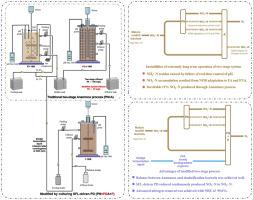Journal of Hazardous Materials ( IF 12.2 ) Pub Date : 2021-03-03 , DOI: 10.1016/j.jhazmat.2021.125568 Hao Jiang , Zhong Wang , Shang Ren , Jingang Qiu , Xiyao Li , Yongzhen Peng

|
The two-stage partial nitrification (PN)-Anammox process, during long term treatment of high-ammonia nitrogen leachate, faces challenges such as the adaptation of nitrite oxidation bacteria (NOB) and failure of real-time control of pH. Resultant instabilities including NH4+-N and NO3--N accumulation were overcome by culturing sludge fermentation liquid (SFL)-driven partial denitrification (PD) in situ in the Anammox process. Biodegradation of slowly biodegradable organics (SBO) in SFL created organics restriction condition, which limited the activity of denitrification bacteria and achieved its balance with Anammox bacteria. Produced NO3--N is reduced to NO2--N through PD, which further improved the removal of NH4+-N through Anammox. NO2--N was utilized timely by Anammox bacteria, which avoid further reduction of NO2--N to N2, and result in a high nitrate to nitrite transformation ratio (NTR) of 93.3%. Satisfactory nitrogen removal efficiency (NRE) and nitrogen removal rate (NRR) of 99.6% and 822.0 ± 9.0 g N/(m3∙d) were obtained, respectively. Key genera related to degradation of SBO, PD and Anammox were enriched. The value of narG/(nirK+nirS) increased from 0.05 on day 1–0.15 on day 250. Combining SFL-driven PD with two-stage Anammox process provided a novel insight for applying this process to realize advanced nitrogen removal in practical engineering.
中文翻译:

在两步厌氧发酵过程中培养污泥发酵液驱动的部分反硝化,以实现从成熟垃圾填埋场渗滤液中高级脱氮
在高氨氮浸出液的长期处理过程中,两阶段部分硝化(PN)-厌氧氨氧化工艺面临诸如亚硝酸盐氧化细菌(NOB)适应性和pH值实时控制失败等挑战。通过在厌氧氨氧化过程中原位培养污泥发酵液(SFL)驱动的部分反硝化(PD),可以克服包括NH 4 + -N和NO 3 -- N积累在内的最终不稳定性。SFL中缓慢可生物降解的有机物(SBO)的生物降解产生了有机物限制条件,该条件限制了反硝化细菌的活性并达到了与厌氧氨氧化菌的平衡。产生的NO 3 - -N被还原为NO 2 --N通过PD,进一步改善了通过Anammox去除NH 4 + -N的能力。Anammox细菌及时利用了NO 2 -- N,避免了NO 2 -- N进一步还原为N 2,导致硝酸盐至亚硝酸盐的高转化率(NTR)为93.3%。令人满意的脱氮效率(NRE)和脱氮率(NRR)分别为99.6%和822.0±9.0 g N /(m 3 ∙d)。丰富了与SBO,PD和Anammox降解有关的关键属。的值narG /(nirK + NIRS) 从第1天的0.05到第250天的0.05有所增加。将SFL驱动的PD与两步厌氧氨氧化工艺相结合,为在实际工程中应用该工艺实现高级脱氮提供了新颖的见解。











































 京公网安备 11010802027423号
京公网安备 11010802027423号